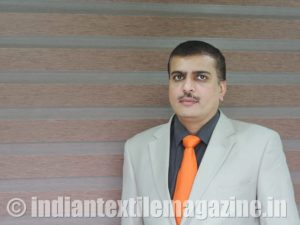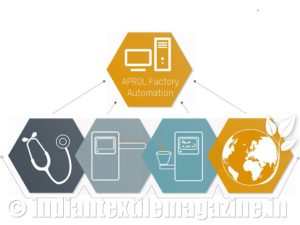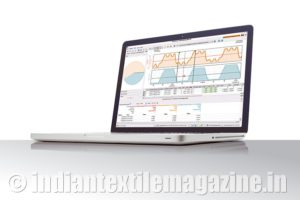The shop floor with innovative automation and least human interference is no more an illusion in the textile industry. Fully automated solutions are available for production management as well as yarn and fabric production until finished production results into faster and efficient processes, thus improving quality. However, the industry cannot reap the full advantages of automation unless effective utilization of equipment in terms of quality and productivity is assured.
Predictive maintenance aims to maximize overall equipment effectiveness, reduce downtimes and wastage and provide factories with a complete asset performance management. It has the ability to track machine performance and anticipate failures before they occur. Asset performance management is becoming an important part of any smart factory.
Predictive maintenance is vital in today’s next generation factories where everyone is looking at optimizing processes, and reducing unplanned downtimes and losses. Many manufacturing set-ups have already realized its importance and employed this Industrial IoT (IIoT) solution to improve product quality and equipment reliability, increasing the overall efficiency. Industrial IoT is opening new doors in terms of accuracy and efficiency for companies when it comes to predictive maintenance.
In order to meet the growing demand of the competitive market, the textile industry works 24/7. Any machine failure can dampen productivity and profitability. Factory owners cannot afford any unplanned breakdown; nor can they waste time in trouble-shooting faults. In such cases, condition monitoring not only allows determining areas for improvement but also helps manufacturers to identify potential problems and take necessary action before failures occur. Condition-based monitoring can detect even the smallest failures early enough, avoiding unplanned machine downtime. This saves cost and time. It is one of the efficient and reliable solutions to keep machines and lines up and running.
Nevertheless, with benefits necessarily come substantial challenges. Connected shop floors in the smart factory daily generate and exchange a huge amount of data, which is expected to further grow in future. Safe and secure transfer of data is a major concern for OEMs and owners of textile facilities. Another challenge is the environmental conditions at the shop floor, which are always plagued with dust, fibers, chemical contaminations and gaseous fumes. Sustainability of controls and sensors in a harsh environment is one of the challenges factories face while implementing condition monitoring. With the right tools and strategy, there are ways to overcome these challenges.
Condition monitoring solutions
Continuous condition monitoring increases the quality of products and availability of machines and factories, while at the same time reducing maintenance costs. APROL ConMon is B&R’s solution for measuring, recording and evaluating all relevant condition parameters to provide optimal support for continual improvement process. APROL ConMon can be used as a standalone solution – independent of any existing building automation control system, SCADA system, process control systems and PLC solutions – or it can be integrated into an existing APROL system. APROL ConMon can be customized to monitor a single machine, an entire factory, a building, a process or a plant.
The ready-to-use solution ensures maximum flexibility with very little engineering. It also makes the implementation of condition monitoring systems (CMS) and asset management considerably easier. With APROL as the platform, it is also possible to implement solutions that go far beyond conventional condition monitoring tasks. Because of its outstanding flexibility, the system can scale up to meet new demands ensuring exceptional long-term investment protection.
With APROL ConMon, alarm and trend systems are available without restrictions. This means that alarm and trend data points defined in the templates are monitored and recorded automatically. It is even possible for factories to set up their own customized reports in the system. All of this data can be accessed freely in web-based standard reports.
Safety and security
Factories are using big data analytics tools to convert enormous volumes of data into valuable information. With big data, cloud connectivity new challenges of safety and security come to the fore. For machine-to-machine and machine-to-cloud communication, B&R trusts in OPC UA, MQTT and AMQP for secure and safe connectivity to cloud. OPC UA is an open source communication protocol widely used in industrial automation applications. It is based on the client-server principle and allows seamless vertical and horizontal connectivity. The protocol is platform-independent and features built-in safety mechanisms.
Since OPC UA is flexible and completely independent, it is regarded as the ideal communication protocol for the implementation of Industry 4.0. B&Rs support for such open technologies helps in reducing the total cost of ownership and provides a common platform for networking due to the vendor independent nature of these protocols.
The vendor neutral approach has helped various vendors adopt such technologies in their controllers, actuators, cameras and other peripheral devices at negligible investment. This helps factories connect machines and devices on a single network, enhancing diagnostics, reducing maintenance and providing seamless connectivity to the cloud. Even cloud platforms have already adopted such open source communication for interfacing with the field devices. OPC UA, Ethernet POWERLINK and MQTT all being open source and Ethernet based provide the necessary bandwidth for such complex and demanding applications.
 “Today, many automated or semi-automated mills are running digitally isolated legacy machines. This makes it difficult for factories to monitor data in real time. To get more out of legacy equipment and make processes more productive and efficient, it is essential to make existing factories flexible and digitally connected cost-effectively. APROL satisfies all the requirements of brownfield as well as greenfield sites, without neglecting the high demands on availability and data consistency. APROL enables factories to implement not only condition monitoring but also energy monitoring and process data acquisition in one system. This is a cost-effective solution for factories, as they do not need different systems for satisfying diverse needs. This can make new installations as well as the existing ones smart and Industrial IoT ready – Mukund Patil, Head Sales & Applications – PFA
“Today, many automated or semi-automated mills are running digitally isolated legacy machines. This makes it difficult for factories to monitor data in real time. To get more out of legacy equipment and make processes more productive and efficient, it is essential to make existing factories flexible and digitally connected cost-effectively. APROL satisfies all the requirements of brownfield as well as greenfield sites, without neglecting the high demands on availability and data consistency. APROL enables factories to implement not only condition monitoring but also energy monitoring and process data acquisition in one system. This is a cost-effective solution for factories, as they do not need different systems for satisfying diverse needs. This can make new installations as well as the existing ones smart and Industrial IoT ready – Mukund Patil, Head Sales & Applications – PFA
By Pooja Patil, Corporate Communications, B&R Industrial Automation


